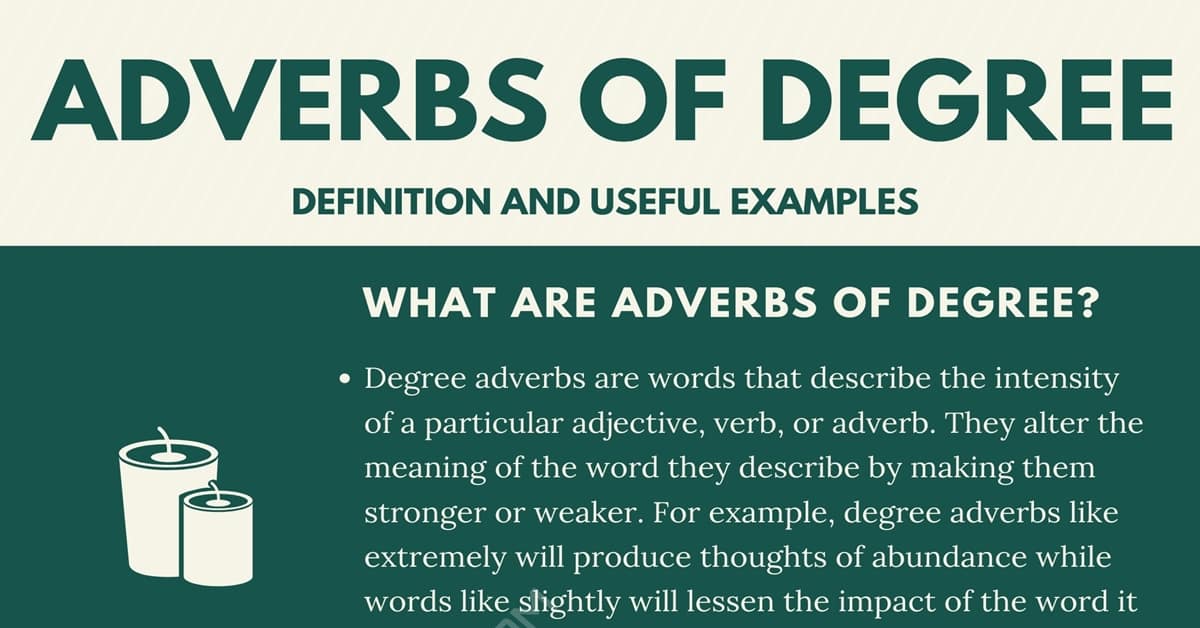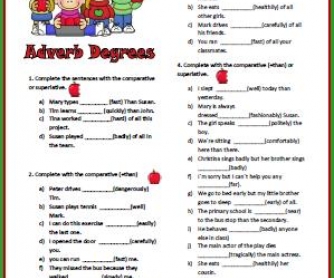Adverb Of Degree Examples Sentences - Adverbs of degree - ESL worksheet by Carla78 : Dogs don't usually walk backwards.. Adverbs of time an adverb of time provides more information about when a verb takes place. Adverbs of time are usually placed at the beginning or end of a sentence. There are a lot of adverbs of degree, here we introduce you to some common ones you should know. When it is of particular importance to express the moment something happened we'll put it at the start of a sentence. George is a truly fantastic.
Adverbs of degree and quantity enhance an adjective, verb or another adverb by describing their intensity. Degree adverbs are used to show the intensity or degree of something. However, manner adverbs, frequency adverbs, time adverbs, degree adverbs and place adverbs are the most commonly used. Let us look at a few examples of how adverbs of degree or quantity are used in a sentence. Enough as an adverb meaning 'to the necessary degree' goes after adjectives and adverbs.

Adverbs of degree tell how much or to what extent. these adverbs are sometimes called intensifiers because they add intensity (either positive or notice how the adverbs of degree in the sentences below add intensity to the words they modify:
Adverbs of degree tell us about the intensity of something. In this way the adverb hotë, for example, became simply hot. Adverbs are words that are used in sentences to describe or change the meaning of a verb or adjective or even another adverb. She was too excited to sleep. Complete the sentences with the english present continuous (score Adverbs of degree are used to provide information about the intensity of an action or adjective. There are a lot of adverbs of degree, here we introduce you to some common ones you should know. They can provide a wide range of information. They tell us the degree or extent to which something happens. Very, too, totally, completely, so, etc. Adverbs of time an adverb of time provides more information about when a verb takes place. Adverbs of time are usually placed at the beginning or end of a sentence. Adverbs of degree and quantity enhance an adjective, verb or another adverb by describing their intensity.
Express intensity with degree adverbs (modifying verbs, adverbs and adjectives); Very, slightly, quite, totally, fairly, absolutely and extremely. Adverbs are words that function as modifiers of sentences, clauses or various elements of clauses. She doesn't quite know what she'll do after university. Other examples of these adverbs are.

Adverbs of degree help us to express 'how much' (or to what extent) we do something.
Click on a topic to learn more about. Very, too, totally, completely, so, etc. Adverbs of degree answer the question 'how much' or 'in what degree' or 'to what extent'. We use adverbs of degree to describe the degree (extent or amount) of an adjective, adverb or verb. I know i'm a very good football player. Adverbs of degree tell us the strength or intensity of something that happens. Adverbs of degree are used to provide information about the intensity of an action or adjective. She was too excited to sleep. Adverbs of degree and quantity enhance an adjective, verb or another adverb by describing their intensity. Adverbs of degree tell how much or to what extent. these adverbs are sometimes called intensifiers because they add intensity (either positive or notice how the adverbs of degree in the sentences below add intensity to the words they modify: Adverbs of time are usually placed at the beginning or end of a sentence. In this way the adverb hotë, for example, became simply hot. Very, too, fully, quite, rather, enough, any, partly in this sentence, where is an adverb as it modifies the verb will be held.
Adverbs of degree are important modifiers. Adverbs of manner express how something for adverbs that answer how much or to what extent, we use adverbs of degree. The adverbs of degree give information about the intensity or degree of an action, adjective or another adverb. Let us look at a few examples of how adverbs of degree or quantity are used in a sentence. We use adverbs of degree to describe the degree (extent or amount) of an adjective, adverb or verb.

Adverbs are words that function as modifiers of sentences, clauses or various elements of clauses.
Adverbs of manner express how something for adverbs that answer how much or to what extent, we use adverbs of degree. I am not quite ready to go. Adverbs of degree can modify verbs, adjectives and other adverbs, and tell us the extent to which something happens. Very, slightly, quite, totally, fairly, absolutely and extremely. Almost, nearly, quite, just, too, enough, hardly, scarcely, completely, very, extremely. Complete the sentence with a degree adverb. Adverbs of time are usually placed at the beginning or end of a sentence. The adverbs of degree give information about the intensity or degree of an action, adjective or another adverb. Complete the sentences with the english present continuous (score Adverbs of time an adverb of time provides more information about when a verb takes place. The adverbs of degree are used to show to what extent or how much has an action been done or will be done. Where is also a relative as it connects the two clauses of the sentence. There is a group of adverbials that come before the main verb and after the (first) special verb if there is one.


0 Komentar